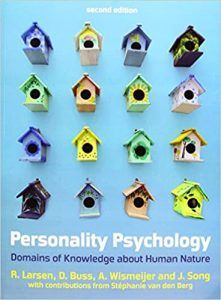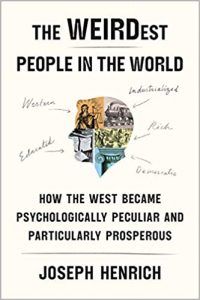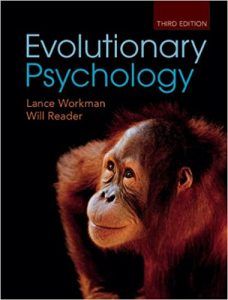Personality Psychology Explained: 7 Theories and Assessments
 At one time or another, we all question who we are and how well we know ourselves. It’s part of the human condition.
At one time or another, we all question who we are and how well we know ourselves. It’s part of the human condition.
The search to understand human nature has been a journey lasting thousands of years, taking us from ancient Greece to modern gene labs.
During that time, there have been many theories of personality, yet they all attempt to answer the same questions.
What makes us who we are, and how do we differ from those around us?
This article introduces a brief history of personality theory before exploring the present, including models, fascinating findings, and how to perform assessments.
Before you continue, we thought you might like to download our three Positive Psychology Exercises for free. These science-based exercises explore fundamental aspects of positive psychology, including strengths, values, and self-compassion, and will give you the tools to enhance the wellbeing of your clients, students, or employees.
This Article Contains:
What Is Personality Psychology?
Our personality is the sum of the psychological qualities that impact our enduring thinking, behavior, and feelings. It is very much part of who we are and how others see us (Allen, Greenlees, & Jones, 2011).
Our personality traits not only define us, but identify how we differ from others (Larsen, Buss, Wismeijer, & Song, 2017). And despite their persistence, every trait and process of personality is not equally active all the time. While aggression may be appropriate when defending oneself from attack, it is not suitable for handing a book in at the library (Nabi et al., 2005).
Personality traits are not separate from who we are; they affect how we act, see ourselves, feel, and interact with others. Not only that, they shape how we view life and the goals we pursue (Larsen et al., 2017).
Therefore, a comprehensive personality theory has several challenges. It must explain how every human is, to some degree (Kluckhohn & Murray, 1948; Larsen et al., 2017):
- Like all others
We all have the capacity to feel love and a need for companionship (known as universals or human nature). - Like some others
We each vary in our need for belonging (known as particulars or individual differences). - Like no others
We are unique in how we express our feelings (known as our individual uniqueness).
As therapists working with clients, it can be useful to walk through the elements of personality theory with our clients. An understanding that they share much of who they are with other humans and, yet, remain unique and special may offer both comfort during difficult times and encouragement when attempting to grow.
A Brief History of the Field

After all, much of psychology’s current thinking owes a considerable debt to the long, complex, and interweaving trail of ideas, thinkers, and research into personality.
While we could begin much earlier, we will instead start in the early years of the 20th century.
Psychoanalysis and the early theories of personality
In 1921 German psychiatrist Ernst Kretschmer suggested that body shape was linked to personality. In his view, a slim, delicate person is much more likely to be introverted than someone strong and muscular. Despite a lack of empirical evidence, this idea was further developed in the 1930s by William Sheldon. He created a scoring system that linked body appearance to a set of personality traits (Holzman, 2020).
Around that time was also the rise of psychoanalysis, driven by the Austrian neurologist Sigmund Freud. He began by focusing on psychopathologies – such as hysteria and phobic conditions – before moving into psychoanalysis and personality development and functioning.
Freud believed that neurotic conditions were rooted in distressing episodes from the past – mostly real or imagined sexual fantasies – that were incompatible with the person’s current moral standards. Such conflicts between human drives (the id) and the primarily unconscious structures that control them (the ego) were thought to lead to lasting self-criticism (Freud, 1922; Holzman, 2020).
Swiss psychiatrist Carl Jung arrived at a theory of personality development that was less driven by sexual desires, yet more abstract, and at times, even spiritual (Holzman, 2020).
Austrian psychiatrist Alfred Adler, a contemporary of Jung, also challenged the importance of sexual motives in defining who we are. Instead, he suggested that our behavior continually hangs in a balance; we exaggerate one behavior to compensate for a deficiency in another (McAdams, 1997).
Erik Erikson, an American psychoanalyst, proposed eight stages of psychosocial growth – or personality transformation. The next phase only emerges upon successful completion of the existing one.
But what does this mean for personality?
Psychoanalytic theory – borne out of psychoanalysts’ consulting rooms – was largely untestable but did provide a starting point for the subsequent development of frameworks for personality research and was the beginning of client-focused therapy.
Earlier personality theories tend to focus on the human nature level, providing a universal account for humans as a species. While such grand theories are historically interesting, they fail to explain what makes us unique (Larsen et al., 2017).
Trait theories of personality
From the 1940s onwards, several investigators including Gordon Allport, Henry Murray, and Raymond Cattell began exploring the personality traits’ stability and hierarchy. Rather than based on single key characteristics, they found personality to be a “unified and organized totality” (McAdams, 1997).
And yet, by 1971, Rae Carlson claimed that the field had lost its way, misplacing the person in personality research (McAdams, 1997).
By the 1980s, many researchers had accepted that personality was a function of both traits and situation – the interaction between person and environment. Over this time, personality psychologists were spending a great deal of time attempting to “reach a single systematic taxonomy for personality traits” (McAdams, 1997).
Perhaps the most celebrated trait psychologist, Hans Eysenck, produced a taxonomy of personality firmly rooted in biology (Eysenck & Eysenck, 1975). Not only was it highly heritable, but it also helped to explain how individuals differed.
Eysenck organized personality into three main traits, psychoticism (P), extraversion–introversion (E), and neuroticism–emotional stability (N), memorable as the acronym PEN. For example, we might typically think of extroverts as liking parties and having many friends; neurotics as anxious, irritable worriers; and the psychotic as egocentric or aggressive.
However, despite the theory’s strengths, the model has since been considered limited in its number of traits. And while Raymond Cattell created an extended taxonomy of 16 personality factors, he could not replicate how he found them (Larsen et al., 2017).
3 Scientifically Proven Personality Theories
Contemporary personality research has a strong focus on individual and group differences (such as between men and women, and across cultures, etc.). It typically sets out to answer the following questions (Larsen et al., 2017):
- How many personality traits are there?
- How are they organized?
- What is their origin?
- What are their consequences?
By answering the questions, psychologists can explain how we differ, behave, and perform (Laajaj et al., 2019).
Several of the personality models receiving the most attention at present include:
Five-factor model
The five-factor model of personality, also known as the Big Five, is a suggested taxonomy of personality consisting of the following traits (McCrae & John, 1992):
- Openness
- Conscientiousness
- Extraversion
- Agreeableness
- Neuroticism
The creation of the model and agreement of its traits resulted from a statistical and linguistic analysis of natural language.
Crucially, the five-factor model has proven highly reliable at describing the basic personality dimensions and how we differ. Indeed, the model has been successfully proven over the last five decades across multiple languages (Larsen et al., 2017).
However, despite its replicability, there have been challenges to labeling some of the existing traits and the suggestion of a sixth factor known as Honesty–Humility (Hilbig & Zettler, 2015).
HEXACO model of personality
Canadian psychologists Michael Ashton and Kibeom Lee presented their six-factor model known as HEXACO in 1994 (Larsen et al., 2017). It consists of:
- Honesty-Humility – sincerity, fairness, modesty, etc.
- Emotionality – fearfulness, anxiety, dependence, etc.
- eXtraversion – social self-esteem, social boldness, liveliness, etc.
- Agreeableness – forgiveness, flexibility, gentleness, etc.
- Conscientiousness – organization, diligence, perfectionism, etc
- Openness to experience – creativity, curiosity, etc
While similar to the Big Five, there are several significant differences. For example, in the Big Five model, irritability and a quick temper fall under neuroticism; in HEXACO, they are found in agreeableness.
Although the Big Five model remains the dominant model, over 150 published studies use HEXACO, and the body of research continues to grow (Larsen et al., 2017).
Evolutionary theory
In 1848, Charles Darwin wrote On the Origin of Species. Its impact was phenomenal (Darwin, 1859). Not only was its effect on explaining the diversity of species profound, but more recently, it has had a significant impact on psychology in the form of evolutionary psychology.
Research into twins’ personalities has found that between 30% and 50% of people’s variation is genetic. However, this also means that between 50% and 70% of our personality is environmental. Such factors include (Workman & Reader, 2015):
- Treatment as a child
- Mother’s lifestyle during pregnancy
- Birth trauma, such as oxygen starvation
- Childhood diseases
- Good and bad experiences throughout life
For evolutionary theory to successfully explain personality, it will need to answer the following two questions:
- Why do particular personality traits pass down through the generations (30–50%)?
- Why is the remaining 50–70% of personality left to chance?
Evolutionary theory may ultimately offer psychology a grand unifying theory, but it isn’t there yet (Buss, 2016).
Research continues in this exciting and fruitful area and will undoubtedly lead to further understanding of the effect of both nature and nurture on who we are and how we behave.
While the above three theories (and others) continue to develop and be challenged, and as new ones arise, it is crucial to remember that a personality theory should be judged by its ability to:
- Explain the empirical data (observations of personality and behavior)
- Offer a guide to new and important discoveries
- Be precise enough to be testable
- Contain few assumptions and premises; it should be possible to explain findings based on the theory, rather than relying on a complex set of caveats
- Be consistent with well-established thinking inside and outside psychology
4 Fascinating Facts and Research Findings
With many more personality theories abounding, it is interesting to investigate the research results which either prove, or disprove, such theories. We share a few interesting research results.
Sensation seekers

Research has shown that people who inherit a variation of the D4DR gene do not feel the effect of dopamine – involved in motivation and arousal – as much as others.
Studies suggest that such differences can lead to potentially dangerous, thrill-seeking behavior as individuals attempt to feel the dopamine pathways’ full effect (Eichhammer et al., 2005).
Shyness, anxiety, and eating disorders
Research has linked variations of another gene, 5-HTT, to shyness.
Several studies suggest that differences in the gene expression impact coping with anxiety and the prevalence of eating disorders (Monteleone, Tortorella, Castaldo, & Maj, 2005; Workman & Reader, 2015).
Personality research is WEIRD
Research into personalities of Americans and other WEIRD populations (Western, educated, industrialized, rich, and democratic) may not be as representative as previously thought (Henrich, 2020).
According to Joseph Henrich, the evolutionary approach suggests that our dispositions are calibrated based on the social and economic environments with which we are confronted throughout our lives.
Our personality is influenced by where we are brought up.
Therefore, we should be careful about how we ascribe the findings of personality research in restricted populations to those culturally very different from ourselves.
Personality impacts sports
Personality plays a crucial role in sporting success and can even impact the sports people play.
Athletes are typically more extroverted and less neurotic than non-athletes, and individual athletes are more conscientious than team players. However, team players tend to be more agreeable than lone sportspeople (Allen et al., 2011; Nia & Besharat, 2010).
Such findings are significant as they can influence coping and the choice of subsequent coaching interventions.
Measuring personality: crash course psychology #22
Assessing Personality: 2 Valid Tests and Questions
The following personality tests are widely used, and two have repeatedly passed scientific scrutiny. They also offer useful insights into clients’ personalities for purposes of coaching and therapy.
Big Five personality inventory
The popular Big Five personality inventory, based on the five-factor model, has been widely validated.
The test consists of 44 questions answered on a scale between 1 and 5 (1 – disagree strongly, 5 – agree strongly) (Kaiseler, Polman, & Nicholls, 2012; Sutton, 2019).
Questions include:
I am a person who is talkative.
I am a person who finds fault in others.
I am someone who is reserved.
HEXACO Personality Inventory
The HEXACO-PI-R is growing in popularity and is a scientifically validated assessment.
Each domain is scored on four different facets. For example, extraversion is measured based on social self-esteem, social boldness, sociability, and liveliness (Larsen et al., 2017).
Each person is typically scored on their response to 100 statements (though a 60-item test is also available) such as:
I wouldn’t pretend to like someone to get that person to do favors for me.
I feel like crying when I see other people crying.
On most days I feel cheerful and optimistic.
Myers-Briggs Type Indicator
This test is worth mentioning briefly as it is popular in business but has been challenged repeatedly by academic research.
Despite academic misgivings, the Myers-Briggs Type Indicator (MBTI) is often used to determine staff appropriateness for positions (Myers, McCaulley, Quenk, & Hammer, 1998).
Each person is scored on eight fundamental preferences:
- Extraversion
- Introversion
- Sensing
- Intuition
- Thinking
- Feeling
- Judging
- Perceiving
Despite broad appeal and utility, the MBTI has been strongly criticized by researchers for its failure to meet rigorous theoretical criteria. It not only lacks testability, but also has internal contradictions (Stein & Swan, 2019).
According to Randy Larsen, the test may have some limited value in getting people to think about their personality but should not solely decide a person’s fit for a job (Larsen et al., 2017).
3 Books on the Topic
The following three books approach the exciting field of personality from very different (yet overlapping) angles to offer a more complete view of the subject matter.
1. Personality Psychology: Domains of Knowledge About Human Nature – R. Larsen, D. Buss, A Wismeijer, and J. Song
This first book is an incredibly well-put-together and comprehensive guide to personality, covering all key knowledge domains in the field.
Larsen and colleagues review the scientific basis for classical and contemporary theories and the latest developments in intelligence, genetics, and personality disorders.
Find the book on Amazon.
2. The WEIRDest People in the World: How the West Became Psychologically Peculiar and Particularly Prosperous – Joseph Henrich
Joseph Henrich’s engaging book is an interesting challenge to psychology and its community of researchers and academics.
How can we map our understanding of who we are on to other cultures when our research is often restricted to WEIRD (Western, educated, industrialized, rich, and democratic) cultures?
Henrich also provides a unique standpoint that helps us look at how WEIRD populations became so psychologically peculiar.
Find the book on Amazon.
3. Evolutionary Psychology: An Introduction – Lance Workman and Will Reader
This comprehensive volume is the ideal introduction and companion to evolutionary psychology for students, practitioners, and the interested public.
The book is full of the latest research, and Lance Workman and Will Reader introduce the challenges, issues, and advances that have faced evolutionary psychology in recent years.
Find the book on Amazon.
PositivePsychology.com’s Related Resources
Try out some of the tools and worksheets below with your clients to help them understand how they emotionally react to situations and can know themselves better.
- Getting To Know Yourself is a great place to start. Clients can use the boxes to help them remind themselves of who they are.
- Signs of Emotional Discomfort can help them to spot the signals that suggest they are becoming more agitated and responding poorly to life events.
- Exploring Our Feelings helps your clients reflect on the frequency and content of their emotions.
- Emotional Awareness can increase emotional intelligence by encouraging clients to track their emotional states throughout the day.
- Mapping Emotions directs your clients’ attention to bodily experiences of emotion to reach a greater acceptance of feelings.
If you’re looking for more science-based ways to help others enhance their wellbeing, this signature collection contains 17 validated positive psychology tools for practitioners. Use them to help others flourish and thrive.
A Take-Home Message
Ultimately, we all share a set of common needs, wishes, and desires with our fellow humans, including the desire to know who we are. Yet, we are all unique. We vary in our strengths and weaknesses and have individual differences in our personalities.
As individuals (and clients), we can each be encouraged to celebrate what we share with others – to gain empathy and understanding – while recognizing and valuing our uniqueness.
After all, this is what it means to be human and defines who we are as individuals.
A sense of our personality – knowing who we are – can help give us that understanding.
Genetics, the study of evolutionary psychology, and ongoing trait analysis will continue to offer more significant insights into our personality. And rather than limit our choices, improved understanding will open the door to showing us what we should accept and treasure in ourselves and where we may need support from professionals.
For the therapist, such knowledge of our client and their self-awareness can be empowering, leading to bigger, more appropriate, and long-lasting changes that are individual and specific, yet considerate of others.
We hope you enjoyed reading this article. Don’t forget to download our three Positive Psychology Exercises for free.
- Allen, M. S., Greenlees, I., & Jones, M. V. (2011) An investigation of the five-factor model of personality and coping behaviour in sport. Journal of Sports Sciences, 29, 841–850.
- Buss, D. M. (2016). Evolutionary psychology: The new science of the mind. Routledge, Taylor & Francis Group.
- Carlson, R. (1971). Where is the person in personality research? Psychological Bulletin, 75(3), 203–219.
- Darwin, C. (1859). On the origin of species. Murray.
- Eichhammer, P., Sand, P. G., Stoertebecker, P., Langguth, B., Zowe, M., & Hajak, G. (2005). Variation at the DRD4 promoter modulates extraversion in Caucasians. Molecular Psychiatry, 10(6), 520–522.
- Eysenck, H. J. & Eysenk, M. W. (1975). Personality and individual differences: A natural science approach. Plenium Press.
- Freud, S. (1922). Beyond the pleasure principle. The International Psycho-Analytical Press.
- Henrich, J. P. (2020). The WEIRDest people in the world: How the West became psychologically peculiar and particularly prosperous. Penguin Books.
- Hilbig, B. E., & Zettler, I. (2015). When the cat’s away, some mice will play: A basic trait account of dishonest behavior. Journal of Research in Personality, 57, 72–88.
- Holzman, P. (2020). Personality. Retrieved December 1, 2020, from https://www.britannica.com/topic/personality
- Kaiseler, M., Polman, R. C. J., & Nicholls, A. R. (2012). Effects of the Big Five personality dimensions on appraisal coping, and coping effectiveness in sport. European Journal of Sport Science, 12(1), 62–72.
- Kluckhohn, C., & Murray, H. A. (Eds.). (1948). Personality in nature, society and culture. Knopf.
- Laajaj, R., Macours, K., Pinzon Hernandez, D. A., Arias, O., Gosling, S. D., Potter, J., … Vakis, R. (2019). Challenges to capture the big five personality traits in non-WEIRD populations. Science Advances, 5(7).
- Larsen, R., Buss, D., Wismeijer, A., & Song, J. (2017). Personality psychology: Domains of knowledge about human nature. McGraw-Hill Education.
- McAdams, D. P. (1997). A conceptual history of personality psychology. In R. Hogan, J. Johnson, & S. Briggs (Eds.), Handbook of personality psychology (pp. 3–39). Academic Press.
- McCrae, R. R., & John, O. P. (1992). An introduction to the five-factor model and its applications. Journal of Personality, 60, 175–215.
- Monteleone, P., Tortorella, A., Castaldo, E., & Maj, M. (2005). Association of a functional serotonin transporter gene polymorphism with binge eating disorder. American Journal of Medical Genetics Part B: Neuropsychiatric Genetics, 141B(1), 7–9.
- Myers, I. B., McCaulley, M. H., Quenk, N. L., & Hammer, A. L. (1998). Manual: A guide to the development and use of the Myers-Briggs Type Indicator. Consulting Psychologists Press.
- Nabi, H., Consoli, S. M., Chiron, M., Lafont, S., Chastang, J. F., Zins, M., & Lagarde, E. (2005). Aggressive/hostile personality traits and injury accidents: An eight-year prospective study of a large cohort of French employees – the GAZEL cohort. Psychological Medicine, 36(3), 365–373.
- Nia, M. E., & Besharat, M.A. (2010). Comparison of athletes’ personality characteristics in individual and team sports. Social and Behavioral Sciences, 5, 808–812.
- Stein, R., & Swan, A. B. (2019). Evaluating the validity of Myers-Briggs Type Indicator theory: A teaching tool and window into intuitive psychology. Social and Personality Psychology Compass, 13(3).
- Sutton, J. (2019). Psychological and physiological factors that affect success in ultra-marathoners (Doctoral thesis, Ulster University). Retrieved December 1, 2020, from https://pure.ulster.ac.uk/en/studentTheses/psychological-and-physiological-factors-that-affect-success-in-ul
- Workman, L., & Reader, W. (2015). Evolutionary psychology: An introduction. Cambridge University Press.
Let us know your thoughts
Read other articles by their category
- Body & Brain (49)
- Coaching & Application (57)
- Compassion (26)
- Counseling (51)
- Emotional Intelligence (24)
- Gratitude (18)
- Grief & Bereavement (21)
- Happiness & SWB (40)
- Meaning & Values (26)
- Meditation (20)
- Mindfulness (45)
- Motivation & Goals (45)
- Optimism & Mindset (34)
- Positive CBT (28)
- Positive Communication (20)
- Positive Education (47)
- Positive Emotions (32)
- Positive Leadership (18)
- Positive Parenting (4)
- Positive Psychology (33)
- Positive Workplace (37)
- Productivity (16)
- Relationships (46)
- Resilience & Coping (36)
- Self Awareness (21)
- Self Esteem (37)
- Strengths & Virtues (31)
- Stress & Burnout Prevention (34)
- Theory & Books (46)
- Therapy Exercises (37)
- Types of Therapy (64)








What our readers think
The review was useful
Thank you! This helps more than you know.